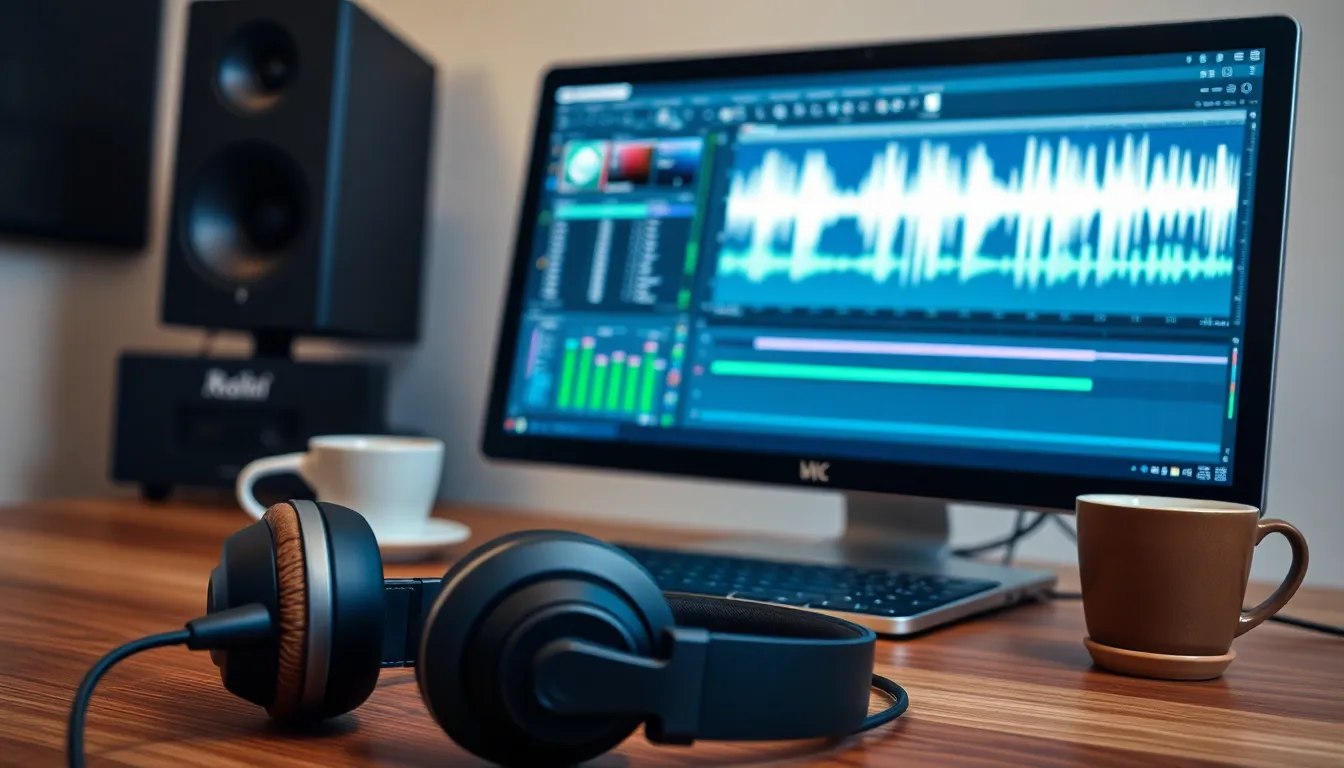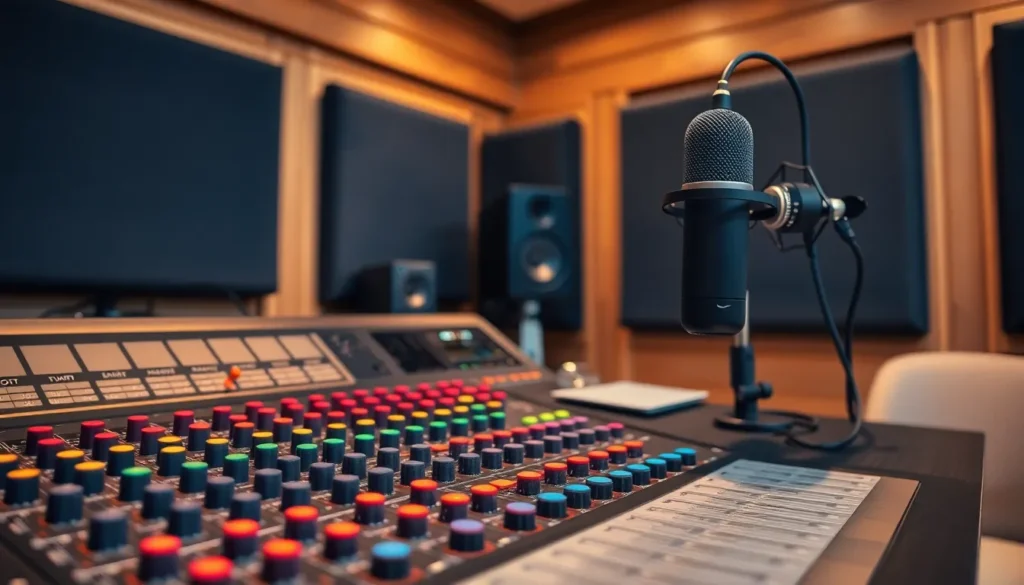In the world of podcasting, every second counts. With countless shows vying for listeners’ attention, the difference between a hit and a flop often boils down to sound quality. Enter podcast compression settings—the secret weapon that transforms amateur audio into a polished masterpiece. If you’re tired of your voice sounding like it’s trapped in a tin can or your guest’s laughter echoing like a bad sitcom, it’s time to get serious about compression.
Understanding Podcast Compression Settings
Effective compression settings play a crucial role in optimizing podcast sound quality. Achieving clarity and balance enhances the listener’s experience significantly.
Importance of Compression in Podcasts
Compression controls audio dynamics, balancing loud and soft parts of recordings. Balanced sound makes verbal content clearer and more enjoyable. High peaks and low valleys in audio can create distractions. Using compression ensures a consistent listening volume across different playback devices. Properly set compression parameters allow podcasters to maintain voice clarity, reducing background noise and echo interference. Enhanced audio quality can attract and retain listeners, contributing to a podcast’s overall success.
Overview of Common Compression Formats
MP3 remains the most popular audio format for podcasts. Its balance between file size and sound quality makes it user-friendly. AAC offers superior quality at similar bit rates, resulting in clearer sound reproduction. WAV is notable for its high fidelity but generates large file sizes. Ogg Vorbis serves as a free alternative to MP3, maintaining good audio quality while reducing file size. Each format has unique advantages that influence how podcasts are distributed and consumed. Understanding these options helps podcasters make informed decisions about their audio outputs.
Recommended Compression Settings

Choosing the right compression settings optimizes podcast sound quality. Adjusting these can significantly enhance listener experience.
Bitrate Recommendations
Bitrate affects audio quality directly. A common recommendation for voice podcasts is 64 kbps, which balances quality and file size effectively. For music-heavy content, opt for 128 kbps or higher to maintain audio clarity during complex passages. Some podcasters prefer 192 kbps for an even better listening experience, especially for high-energy segments. Select a bitrate considering the distribution platform; for instance, most streaming platforms suggest using 128 kbps as a minimum.
Sample Rate Guidelines
Sample rate defines how frequently audio is sampled per second. Standard rates include 44.1 kHz for music and 48 kHz for video. Podcasts often use 44.1 kHz due to its compatibility with most playback devices. Higher sample rates, like 96 kHz, may benefit professional-grade recordings but can increase file sizes significantly. Always match the sample rate to the content type; voice-focused podcasts thrive at lower rates, while music-centric shows benefit from higher rates. Selecting the correct sample rate ensures audio playback aligns correctly across various platforms.
Tools for Podcast Compression
Various tools can assist in optimizing audio for podcasts. Software and hardware options both play crucial roles in achieving desirable compression settings.
Software Options
Many software applications cater to podcast compression needs. Popular choices include Audacity, Adobe Audition, and GarageBand. Audacity provides a free, user-friendly interface ideal for beginners, while Adobe Audition offers advanced features suitable for professionals. GarageBand, exclusive to Apple devices, integrates well with other Apple software. Each application supports various audio formats and allows detailed manipulation of compression settings, enabling podcasters to fine-tune their audio dynamics effectively.
Hardware Solutions
Several hardware solutions enhance podcast compression quality. Devices like audio interfaces and digital audio recorders optimize sound capture before editing. Audio interfaces, such as the Focusrite Scarlett series, provide superior quality during input with low latency and clear sound. Digital audio recorders like the Zoom H5 offer portability and excellent audio fidelity. Investing in quality microphones also boosts audio clarity and reduces background noise, significantly improving the podcast’s overall sound quality.
Best Practices for Podcast Compression
Effective compression settings significantly enhance podcast audio quality. Following best practices ensures a polished listening experience.
Testing and Adjusting Settings
Testing settings before finalizing them is critical. Begin by exporting a short clip using the chosen compression parameters. Play the audio on different devices to check consistency and clarity. Adjust accordingly based on feedback from various playback systems. Regularly revisiting and tweaking settings can yield noticeable improvements in audio quality, especially when experimenting with different formats. Incrementally modifying one parameter at a time aids in pinpointing optimal configurations, enhancing voice clarity and overall balance.
Avoiding Common Pitfalls
Avoiding common pitfalls in compression leads to better sound quality. Over-compressing audio can result in distortion and loss of dynamic range. Strike a balance that maintains clarity without sacrificing expression. Failing to consider the target audience’s playback devices can also lead to issues. Many listeners use earbuds or mobile devices, which may accentuate audio flaws. Ensure that settings cater to typical playback scenarios. Ignoring file size implications risks making content less accessible. Keep file sizes manageable while maintaining quality to attract a broader audience.
Mastering podcast compression settings is essential for achieving high-quality audio that captivates listeners. By understanding the balance between clarity and dynamics, podcasters can elevate their content from amateur to professional.
Utilizing the right tools and adhering to best practices ensures that each episode sounds its best across various platforms. Regularly testing and adjusting settings can lead to significant improvements, making it easier for audiences to enjoy the content without distractions.
Ultimately, investing time in compression techniques not only enhances sound quality but also contributes to a podcast’s overall success and listener satisfaction.






